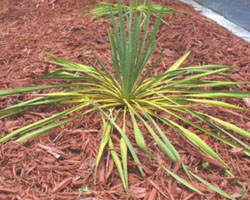Yucca filamentosa - Bear grass, Adam's needle



Family Agavaceae
Description:
Approximately twenty to thirty species of Yucca are found in North and Central America and the Caribbean. They range from relatively small, trunkless species to tall, branched trees. Bear grass is native to the southeastern United States, including the UNF campus. The evergreen leaves are arranged in a rosette on the ground. As the plant grows, more rosettes grow around the original creating a clump. Flowers are white and bell-shaped on a tall spike. Pollination of the flowers is unusual. A small white moth, the yucca moth, collects pollen and pushes it into a special receptacle in the flower ensuring fertilization and the production of seeds. Unlike most pollination, this is no accident. The moth will lay eggs on the developing seed capsule. Its larvae eat part of the capsule but leave some seeds so the plant can reproduce. The moth's larvae feed on nothing but yucca seed capsules.
Flowers and fruits of some yucca species are eaten. Roots of some species are used in the manufacturing of soap.
Location:
Wild plants can be found in drier natural areas around campus. Plants of the variegated variety, 'Bright Edge', can be seen on the west side of building 39.
Size:
Small shrubs with a short stem and leaves to about two to three feet long. The flower spike rises above the leaves, up to four to eight feet tall.
Care Instructions:
Light: full sun to part shade
Water: very drought tolerant once established, does not survive in wet sites
Soil: well-drained, low fertility, wide pH tolerance, no special requirements
